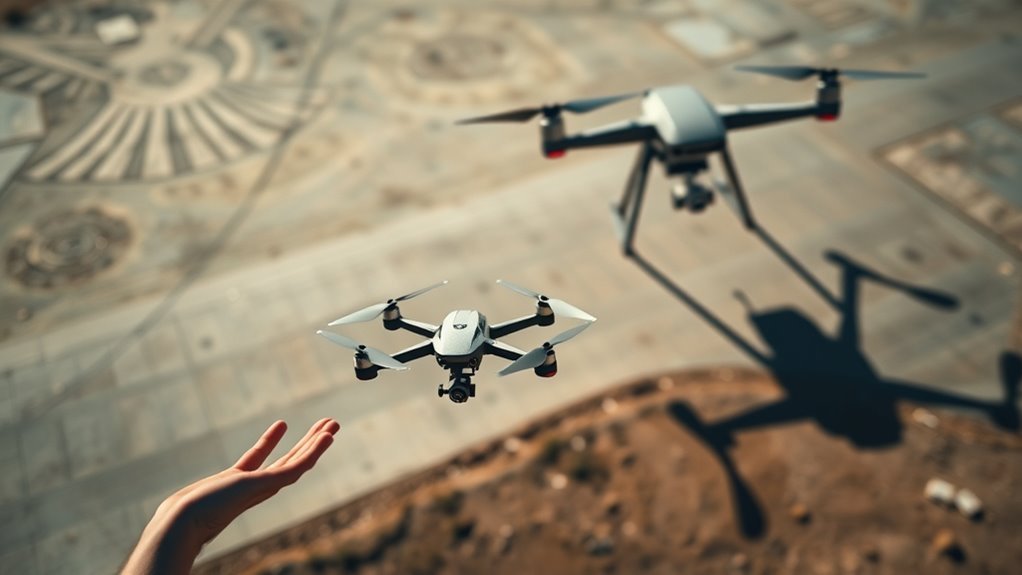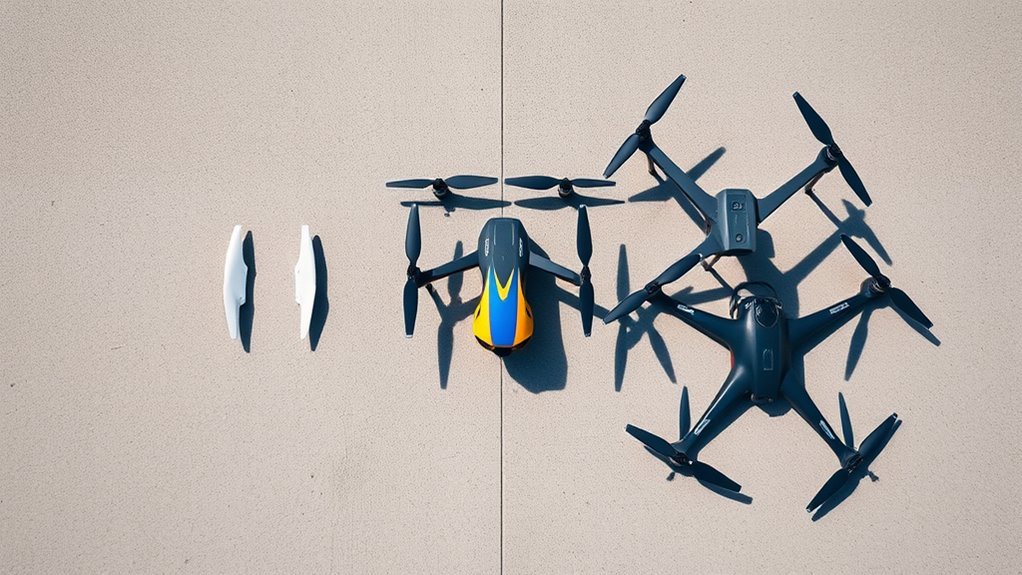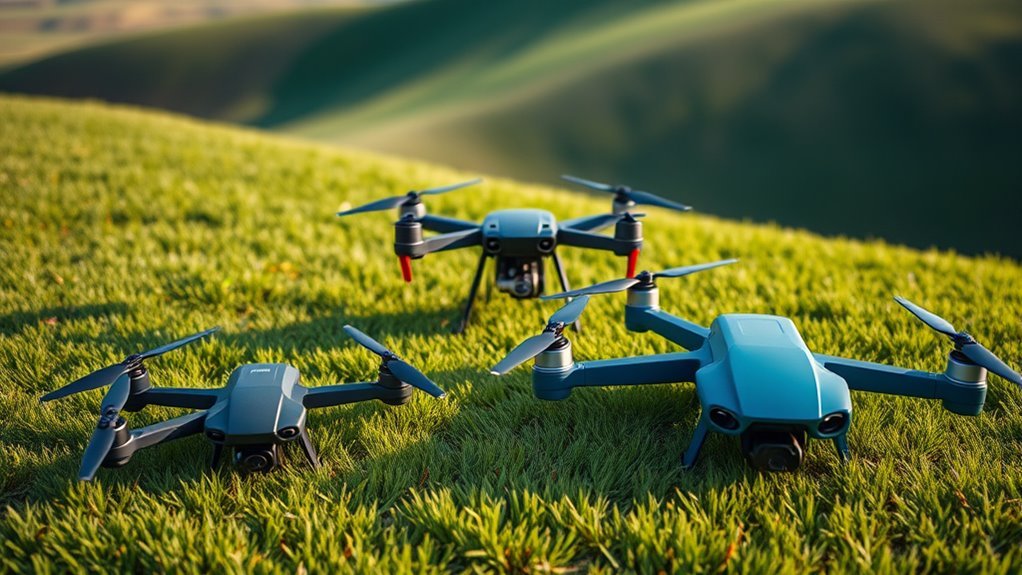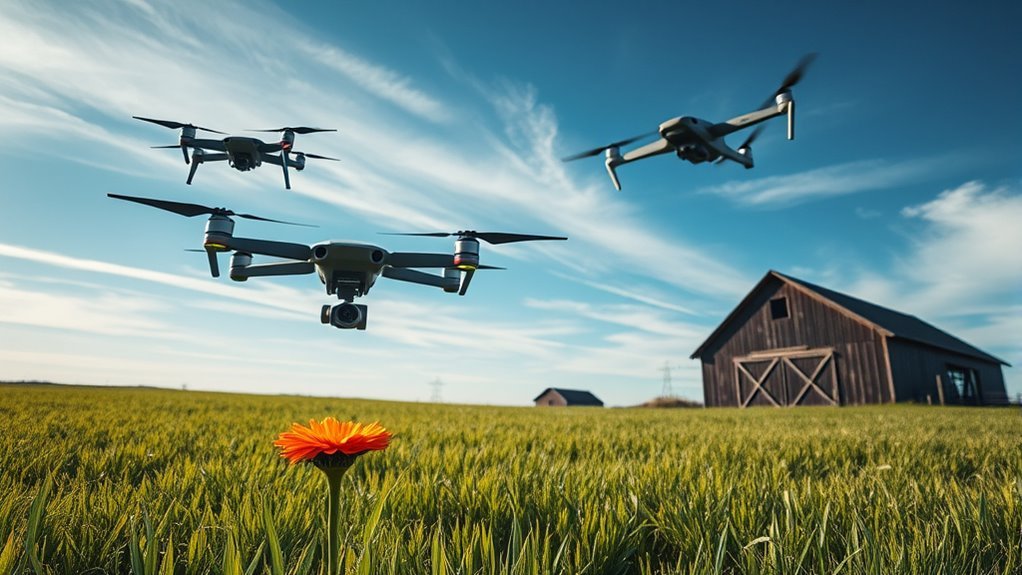Drones are categorized by size, each serving distinct functions. Micro drones weigh less than 250 grams, while mini drones offer compact design with advanced features. Small drones weigh under 5 pounds, providing versatility for various tasks. Medium drones range from 5 to 25 pounds, combining stability with payload capacity. Large drones handle up to 100 pounds for heavy tasks. Extra-large drones exceed 200 kilograms for industrial use. Want to explore how these sizes impact performance and applications?
Micro Drones: The Smallest Flyers

Micro drones, often weighing less than 250 grams, represent the smallest category in the drone size spectrum. These devices leverage advanced micro drone technology, enabling a range of innovative micro drone applications. You’ll find them utilized in fields like agriculture for crop monitoring, where their compact size allows them to navigate tight spaces and gather data efficiently. In search and rescue missions, their agility can provide essential situational awareness in challenging environments. Additionally, micro drones are increasingly popular in surveillance, offering discreet monitoring capabilities. Their lightweight design promotes ease of transport and deployment, granting users the freedom to operate in diverse scenarios. As technology advances, expect even broader applications and enhanced features that push the boundaries of what micro drones can achieve. Furthermore, their flight characteristics, like control range, significantly influence their operational capabilities in various settings. Due to their reduced radar cross-section, micro drones can evade detection more easily compared to larger drones, making them particularly useful in sensitive operations.
Mini Drones: Compact and Convenient

While mini drones may be slightly larger than their micro counterparts, they still offer an impressive balance of size and functionality. These compact devices often come equipped with advanced mini drone features like high-definition cameras, GPS capabilities, and extended battery life, making them ideal for a range of applications. You can use mini drones for recreational purposes, such as aerial photography or racing, as well as professional tasks, including surveying and inspection work. Their lightweight design enhances portability, allowing you to take them anywhere with ease. Given their versatility, mini drones serve as an excellent tool for those seeking freedom in both hobbyist and professional activities, providing endless possibilities without overwhelming complexity. Additionally, hover precision and stability features significantly enhance their performance, ensuring smooth operation even in challenging conditions. Furthermore, the incorporation of advanced camera capabilities allows for high-quality visual content, making mini drones even more appealing for creative and professional use.
Small Drones: Versatile and Portable

Small drones represent a significant evolution in aerial technology, offering a blend of versatility and portability that appeals to both hobbyists and professionals. These compact devices come equipped with portable features that allow for easy transport and quick deployment in various environments. Their versatile applications range from aerial photography to surveying and even search and rescue operations. With their lightweight design, small drones like the Dji Mini 2 enhance flight efficiency while making it easier to carry them on outdoor adventures. Additionally, small drones often include advanced transmission systems, which improve signal strength and control responsiveness during flights.
| Feature | Description |
|---|---|
| Weight | Typically under 5 pounds |
| Flight Time | Up to 30 minutes |
| Camera Options | HD to 4K resolution |
| Control Range | Up to 1 mile |
With their unique capabilities, small drones empower users to explore new creative avenues while maintaining the freedom to operate in diverse settings.
Medium Drones: A Balance of Size and Capability
Medium drones offer a compelling blend of size and capability, making them ideal for users who require more power and functionality than small drones can provide. These drones typically weigh between 5 to 25 pounds, striking a balance between portability and performance. One of the primary medium drone advantages is their extended flight time and payload capacity, allowing for more advanced sensors and equipment. This makes them suitable for various medium drone applications, including aerial photography, surveying, and agriculture. They can efficiently cover larger areas while maintaining stability and control. Additionally, medium drones often feature enhanced GPS and obstacle avoidance systems, ensuring reliable operation in complex environments. For instance, the advanced AI integration in some models significantly improves their obstacle avoidance capabilities. With these capabilities, they empower users to explore innovative solutions across multiple industries. Many models, like the DJI Air 3, exemplify the effectiveness of medium drones with their impressive flight time and advanced features.
Large Drones: Enhanced Performance and Stability
When considering large drones, you’ll notice significant flight stability advantages due to their increased size and weight. This enhanced stability translates into smoother operation, especially in challenging weather conditions. Additionally, their larger frame allows for greater payload capacity, enabling you to carry more equipment or supplies on each mission. For instance, the payload capacity of the Freefly Alta 8 is significantly higher, accommodating up to 9 kg, making it ideal for demanding tasks. Large drones like the Harris Aerial also showcase superior impact resistance due to their heavy-duty construction, ensuring reliability in outdoor environments.
Flight Stability Advantages
Although various factors influence a drone’s flight stability, large drones inherently possess design advantages that enhance their performance in turbulent conditions. Their increased size provides a larger surface area for stabilization, allowing for better resistance against wind disturbances. This not only improves flight stability but also contributes to superior aerial maneuverability. The weight distribution in large drones facilitates smoother changes and more controlled movements, making them adept at maintaining a steady course, even when faced with environmental challenges. Additionally, their robust construction typically accommodates advanced stabilization technologies, further enhancing performance. Consequently, you’ll find that large drones can navigate complex aerial environments with greater ease, offering an experience that underscores the freedom of flight while maintaining precision and control.
Payload Capacity Benefits
Large drones not only excel in flight stability but also offer significant advantages in payload capacity, which directly contributes to their overall performance. When it comes to payload efficiency and load effectiveness, these drones can carry heavier and more complex equipment without compromising stability or control. This capability allows you to conduct various missions, from aerial photography to heavy-lift logistics.
| Payload Capacity | Benefits |
|---|---|
| Up to 50 lbs | Increased versatility |
| 50-100 lbs | Enhanced mission scope |
| 100-200 lbs | Ideal for industrial use |
| 200+ lbs | Heavy-lift capabilities |
| Custom configurations | Tailored solutions |
Investing in large drones provides you with the freedom to explore new applications, ensuring your operational goals are met efficiently.
Extra-Large Drones: Heavy-Lifters for Industrial Use
As industries increasingly seek efficient solutions for heavy lifting, extra-large drones have emerged as essential tools for a variety of applications. These drones are specifically designed to transport heavy cargo, making them invaluable in sectors like construction, agriculture, and logistics. With payload capacities often exceeding 200 kilograms, they can easily handle the demands of industrial applications. The integration of advanced navigation and automation technologies allows for precise delivery and reduced operational costs. Additionally, their aerial capabilities enable access to remote or difficult-to-reach locations, enhancing productivity. As regulations evolve to accommodate these innovative machines, industries are poised to leverage extra-large drones for optimized workflows and greater freedom in logistics and material handling. Embracing this technology can remarkably boost efficiency and reduce manual labor. Furthermore, the versatility of these drones can enhance tactical flexibility in various operational scenarios. Their advanced aerodynamics contribute to improved flight efficiency, allowing for longer missions with heavy payloads.
Specialty Drones: Tailored for Unique Applications
While extra-large drones excel in heavy lifting, specialty drones cater to unique and specific applications across various industries. These drones are designed with precision to meet the demands of fields such as agriculture, surveillance, and medical delivery. With drone customization, you can modify payloads, sensors, and software to optimize performance for your specific needs. For instance, agricultural drones equipped with multispectral sensors can analyze crop health, while drones used in search and rescue missions may feature thermal imaging capabilities. The ability to tailor these drones enhances their efficiency and effectiveness in specialty applications, allowing you to harness their full potential. By focusing on your unique requirements, you can select the right specialty drone to achieve your goals seamlessly. Additionally, drones like the Delair UX11 AG and Guardian Agriculture Evtol highlight the importance of advanced safety features and operational efficiency in specialized applications. Furthermore, incorporating multispectral sensors allows for early detection of crop stresses, improving overall agricultural yield.
Choosing the Right Size: Factors to Consider
How do you determine the right drone size for your specific needs? First, consider your size preferences based on usage scenarios. For aerial photography or videography, a mid-sized drone typically balances stability and portability. If you’re focused on racing, smaller drones offer agility and speed. Conversely, larger drones are suited for heavy payloads or long-range missions. Additionally, understanding the typical lifespan of drones can help you choose a size that aligns with your operational goals.
Next, evaluate the environment where you’ll operate. Tight indoor spaces may necessitate a compact design, while expansive outdoor areas might allow for larger models.
Lastly, factor in battery life and flight duration; larger drones often carry more powerful batteries, extending operational time. By aligning size preferences with these considerations, you can guarantee that your drone meets your functional and experiential requirements. Furthermore, understanding the battery life and endurance of different models can help you make an informed choice for extended flights.
Frequently Asked Questions
What Is the Weight Limit for Each Drone Size Category?
When considering drone classifications, it’s essential to understand weight restrictions. Typically, toy drones cap at 0.55 pounds, while larger categories, like commercial and professional drones, can handle up to 55 pounds or more.
How Do Drone Sizes Affect Battery Life and Flight Time?
Drone sizes directly impact battery capacity and flight efficiency. Larger drones generally carry bigger batteries, enhancing flight time. However, increased weight may reduce efficiency, so balancing size and purpose is essential for peak performance.
Can Larger Drones Be Used for Recreational Purposes?
While larger drones might seem like soaring giants, they can absolutely be used for recreational drone usage. Their advanced features, like enhanced stability and longer flight times, offer thrilling experiences for enthusiasts seeking freedom in the skies.
Are There Specific Regulations for Different Drone Sizes?
Yes, drone regulations vary by size classification. Generally, smaller drones face fewer restrictions, while larger models must adhere to stricter rules. You’ll need to familiarize yourself with these regulations to guarantee compliance and freedom in your flights.
What Are the Best Size Options for Aerial Photography?
For aerial photography, ideal drone dimensions typically range from compact models for portability to larger ones for stability and image quality. Each size offers unique aerial photography benefits, enhancing your creative freedom and capturing stunning visuals.

